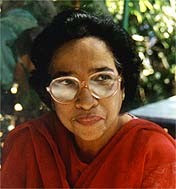
The drive along the Rhine between Koblenz and Bingen is very picturesque. There are some thirty odd castles in the area, all built in the Middle Ages and each with a legend of its own.
Bingen is situated at the junction of the Nahe (dirty muddy water) and the Rhine. It once held a strategic position, and was destroyed eight times by wars, over the last 1000 years.
Today it is a quiet laid back town on the banks of the Rhine. One a small island on the Rhine is the Mouseturm (Mouse Tower), Bingen’s special landmark, where Hatto II the cruel Archbishop of Mainz was eaten up by mice. It later became a signal tower for shipping, and a custom’s outpost.
Bingen however, has been made famous by a woman called Hildegard, a courageous feminist who dared to oppose the powerful Roman Catholic Church’s teachings about women. She defied the Canon Law which prohibited women from preaching, and evolved into a powerful preacher and teacher. She composed music and attested it with her name, refusing to remain anonymous. She studied Botany and became a herbal physician and a healer. She also excelled as a writer of theological books like “Book of Life’s Merits,” and “Book of Divine Love,” which explained her understanding of Salvation History. She even invented her own coded language.
Born into an aristocratic family in 1098, Hildegard was the last of ten children, and was tithed to the Church at the age of eight. She was entrusted to the care of a hermit woman called Jutta of Sponheim, who ran a hermitage. This was attached to the Monastery of Disibod. Here she was provided with minimal education and two meals a day, served at 3 a.m. and 3 p.m. She was a sickly child, who suffered from asthma and migraine.
The Disibod Hermitage attracted so many young women that it grew into a large Benedictine Community. Hildegard took her vows in her teens (1114) and lived quietly in this community for twenty years. Her view of the outside world was only through a window, and her only male contact was her confessor Monk Volmar, who became her friend, and eventually her scribe.
By now, Hildegard was experiencing apocalyptic visions. But when she realized that no one else had similar experiences, she stopped talking about them. However, realization gradually dawned that these visions were prophetic revelations. It prompted her to write her most famous composition SCIVIAS. It took ten years to complete. Because she had the approval of Pope Eugene III, it was read out at the Synod of Trier (1147-1148.)
When Jatta died in1136 Hildegard became the Superior of the Convent. But as this community grew, she felt the compulsion to step out of the cloister. Taking fifty nuns with her, she opened a new convent at Rupertsberg. In 1165, a sister convent was opened at Eibingen, eight miles away.
Hildegard wrote many papers. She built up a voluminous correspondence with clergy, rulers and even lay people. Her focus was on Renewal of the Church. She travelled to different places on preaching tours, making known her views on Creation of mankind and Redemption of the World. Popes, Emperors, nuns and priests sent people to Rupertsberg to hear her messages.
Hildegard was a natural feminist. She would not allow the Church to relegate women to an inferior role. She argued that woman was for man and man for woman, thus making them both of equal status. She taught that sexual pleasure was not a sin, and therefore should not be tainted by guilt; that menstruation was not unclean, but the shedding of innocent blood in wars was definitely unclean. She also opposed the Church’s teaching that woman was not made in the image of God. Rather she believed that in the inner being of God, there was a feminine and masculine relationship, confirming the complementarity of the sexes.
The atmosphere in the convents which she established was liberal. She encouraged the nuns to develop their spiritual, intellectual and artistic talents. There was no dull, somber atmosphere that prevailed in most convents. Here they could sing, play instruments and grow spiritually by listening to lectures on Theology. The nuns lived as normally as possible. They were allowed the luxury of warm baths, daily exercises and beer to put flesh and redness into their cheeks.
During the forty years she presided over Rupertsberg Convent, thousands of pilgrims came there for healing of their medical ailments. The Church ordered her to stop these miracles.
Even at the age of eighty, this feisty lady defied the Church authority, by burying a young man excommunicated by the Church, in the cemetery at Rupertsberg. The Canons ordered the body to be exhumed, but they couldn’t find the spot, as Hildegard had removed all the markers from the graves. The Canons retaliated by prohibiting mass, sacraments and music in the Abbey. The case dragged on for some time and was finally lifted in 1179. She died six months later, and was buried in the Eibingen church.
The Rupertsberg Convent was completely destroyed during the Thirty Year War. All that is left is a vaulted cellar.
In 1998, on Hildegard’s 900th birth anniversary, the Hildegard Forum was constituted at Rocher’s Hill. Since then there has been a renaissance and renewed interest in her visions and mystical knowledge.
A historical museum was also opened in her honour in 1998, in an old electricity generating station on the Rhine.
This daring polymath – a scholar, theologian, healer, writer – will probably never be elevated to sainthood because of her radical views. But Pope John Paul II finally conceded that this maverick saint was a “Doctor of the Church.”






